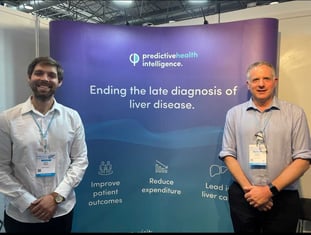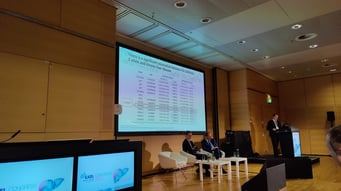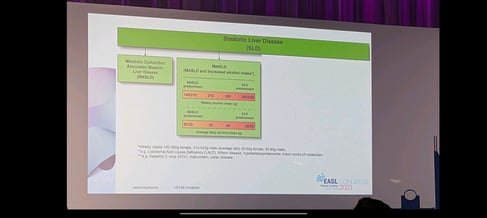Reflections from EASL: Genetic insights, potential treatments, and nomenclature transformations in liver disease

Last week, our team had the privilege of attending the European Association for the Study of the Liver (EASL) conference, where groundbreaking advancements in liver research were unveiled. The conference provided an exceptional platform for experts and researchers to exchange knowledge and foster collaboration in the field of liver disease. In discussions with fellow conference-goers, our team identified several noteworthy themes emerging as key areas of interest. These included the pivotal role of genetics, particularly the PNPLA3 gene, in driving liver fibrosis in NAFLD/MASLD, the significance of AATD SERPINA 1 - PiZZ genotype pathogenicity, and the nomenclature change in NASH and MASH. Here, we will explore these developments, shedding light on the implications they hold for the future of liver disease research and patient care.
The role of genetics in NAFLD/MASLD
In the complex interplay between our genetic makeup and health, certain genetic factors stand out as having a pivotal role, particularly when it comes to liver health. One such genetic player is the Patatin-like phospholipase domain-containing protein 3, or PNPLA3 gene. This gene, first associated with fatty liver disease in a 2008 study, has since been the subject of numerous genome-wide association studies that have underscored its significant role in NAFLD/MASLD. Specifically, the PNPLA3 rs738409 C>G gene variant, recognized for its role in promoting intrahepatic lipid accumulation, is associated with more severe phenotypes, including fibrosis. Given its prevalence in up to 49% of certain populations, this variant poses a substantial public health concern.
The promising development here that was a focus at EASL is the emergence of the PNPLA3 gene, particularly its p.I148M variant, as a potential therapeutic target to counter NAFLD progression. Despite the lack of an approved drug specifically targeting this variant, ongoing research points towards a bright future. Novel therapeutic strategies are being developed and are anticipated to revolutionise the treatment of chronic liver diseases associated with this gene variant.
 Additional genetic research in liver disease shows promise as well, and Sano is pleased to be a part of it – in partnership with Predictive Health Intelligence and Somerset NHS Foundation Trust, we’ve been awarded an £800K grant to find undiagnosed liver disease patients in the UK health system using precision medicine. Tawazun Health will be a key party in this project as well, providing mobile FibroScans.
Additional genetic research in liver disease shows promise as well, and Sano is pleased to be a part of it – in partnership with Predictive Health Intelligence and Somerset NHS Foundation Trust, we’ve been awarded an £800K grant to find undiagnosed liver disease patients in the UK health system using precision medicine. Tawazun Health will be a key party in this project as well, providing mobile FibroScans.
The significance of AATD SERPINA 1 - PiZZ genotype pathogenicity
The SERPINA1 - PiZZ genotype is associated with AATD, one of the most common inherited diseases, and this genotype has been linked to various pulmonary and hepatic conditions. For example, individuals with the PiZZ genotype have a substantially higher risk of many conditions, including liver disease, with these associations being stronger among smokers.
AATD can affect the liver by leading to the accumulation of the AAT protein, which can cause liver damage and disease. While the exact role of AATD and the PiZZ genotype in NASH/NAFLD isn't fully established, it's plausible that there could be a connection, given the liver diseases associated with this genotype. More research is needed in this area to fully elucidate the role of the SERPINA1 - PiZZ genotype in NASH/NAFLD – it was great to see this research in action at EASL.


Nomenclature change
There was also discussion at EASL about the nomenclature change from NASH to MASH (metabolic associated steatohepatitis) and from NAFLD to MASLD (Metabolic-associated Steatotic Liver Disease). Many believe this reflects an evolving understanding of these liver disorders. The updated terms emphasise the strong association between metabolic dysfunction and liver disease, highlighting the multifactorial nature of the conditions. By incorporating the term "metabolic associated," the new nomenclature acknowledges the interplay between genetic factors, lifestyle choices, and metabolic abnormalities in the development and progression of these disorders. This shift in terminology aims to provide a more comprehensive and accurate representation of the underlying pathophysiology, facilitating better clinical characterization and potentially enhancing targeted interventions for patients.
However, this change is not without its challenges. One potential drawback of this transition is the need for widespread adoption and understanding among researchers, healthcare providers, and the general public. Changing established terminology requires a concerted effort to ensure consistent usage and comprehension across various medical disciplines and patient populations. The shift may initially cause confusion or require additional educational efforts to ensure seamless communication and understanding among stakeholders. Nonetheless, with effective dissemination of the updated terminology, these challenges can be overcome, potentially leading to more accurate diagnoses and improved patient care.

Conclusion
As we reflect on the rich discussions and innovative research presented at the EASL conference, it's clear that we are on the cusp of significant advancements in our understanding and management of liver disease. The recognition of the PNPLA3 gene's role in NAFLD/MASLD and its potential as a therapeutic target offers a promising pathway towards more personalised and effective treatments. The continuing exploration of the SERPINA1 - PiZZ genotype's role in liver disease also underscores the importance of genetic research in illuminating the complex landscape of liver pathologies. And, the nomenclature shift from NASH to MASH and NAFLD to MASLD, while requiring careful implementation, symbolises the evolution of our understanding of these disorders, placing a well-deserved spotlight on the critical role of metabolic dysfunction. These advancements, fueled by the collaborative spirit and dedication of the research community, bring hope for improved patient outcomes in the near future.
At Sano Genetics, we are committed to keeping pace with these advancements and contributing to the field. It's an exciting time to be part of this vibrant community, and we look forward to the impacts these developments will have on patient care and the broader field of genetics and liver health. If you’re interested in learning more about potential collaboration with Sano, please get in touch below.
